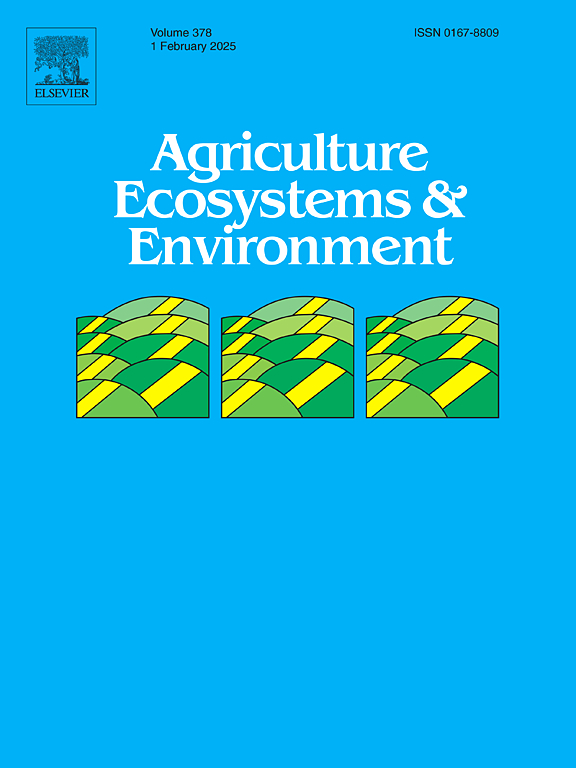Key microbes in wheat maize rotation present better promoting wheat yield effect in a variety of crop rotation systems
IF 6
1区 农林科学
Q1 AGRICULTURE, MULTIDISCIPLINARY
引用次数: 0
Abstract
Rotational cropping is an important and effective agricultural management practice that significantly contributes to crop yields, plant health, and soil structure. Microorganisms invariably accompany crop growth and play a vital role in facilitating plant nutrient uptake, disease resistance, and adaptation to environmental stressors. Given the essentiality of microorganisms in the soil ecosystem, exploring the contribution of soil microbial communities to the rotational cropping system is of significant reference value for improving the rotational cropping system. Although numerous studies have investigated the differences in microbial communities in various crop rotation systems, considering the factors such as the growth stage of wheat, climate, soil fertility, and human activities that exert a significant impact on soil microorganisms, it is imperative to study the effects of different crop rotation systems on soil microbial communities at various growth stages of wheat under controlled experimental conditions. Based on a 12-year long-term rotational cropping platform, we analyzed the composition and structure of bacterial and fungal communities in the rhizosphere of wheat under three crop rotation systems at four growth stages: wheat-maize, wheat-soybean, and wheat-cotton, and constructed a co-occurrence network to identify potential key functional microorganisms. The results showed that both the rotational cropping system and the growth stage of wheat had significant effects on the microbial communities in the long-term rotational cropping system, while the effects of crop rotation systems (R2=0.140) were stronger than growth stage (R2=0.108). And the differences in microbial communities had a certain cumulative effect on the growth and development of wheat. In addition, the rhizosphere microbial co-occurrence network of the wheat-cotton rotational cropping system had 26 key functional microorganisms, much more than those in the other two systems. However, it is worth noting that the key microorganisms in the wheat corn rotation system have a stronger promoting effect on wheat growth. Two of the key functional microorganisms, Niabella_Hub9 and Dokdonella_Hub24, had a significant promoting effect on wheat yield. This study improves the understanding and recognition of the functions and roles of microorganisms in different crop rotation systems, providing a basis for rational utilization and optimization of crop rotation systems.
小麦玉米轮作中的关键微生物在多种轮作系统中呈现出更好的促进小麦增产效果
轮作是一种重要而有效的农业管理方法,对作物产量、植物健康和土壤结构有显著的促进作用。微生物始终伴随着作物的生长,在促进植物养分吸收、抗病和适应环境胁迫等方面发挥着重要作用。鉴于微生物在土壤生态系统中的重要作用,探索土壤微生物群落对轮作系统的贡献对改进轮作系统具有重要的参考价值。尽管已有大量研究调查了不同轮作制度下微生物群落的差异,但考虑到小麦生长阶段、气候、土壤肥力和人类活动等因素对土壤微生物的影响很大,因此在对照实验条件下研究不同轮作制度对小麦不同生长阶段土壤微生物群落的影响势在必行。基于一个为期 12 年的长期轮作平台,我们分析了小麦-玉米、小麦-大豆、小麦-棉花三种轮作制度下小麦四个生长阶段根圈细菌和真菌群落的组成和结构,并构建了共生网络以识别潜在的关键功能微生物。结果表明,轮作制度和小麦生长阶段对长期轮作制度下的微生物群落均有显著影响,而轮作制度的影响(R2=0.140)强于生长阶段(R2=0.108)。微生物群落的差异对小麦的生长发育有一定的累积效应。此外,小麦-棉花轮作系统的根瘤微生物共生网络中有 26 种关键功能微生物,远远多于其他两个系统。但值得注意的是,小麦玉米轮作系统中的关键微生物对小麦生长的促进作用更强。其中两种关键功能微生物 Niabella_Hub9 和 Dokdonella_Hub24 对小麦产量有显著的促进作用。这项研究增进了人们对不同轮作体系中微生物功能和作用的理解和认识,为合理利用和优化轮作体系提供了依据。
本文章由计算机程序翻译,如有差异,请以英文原文为准。
求助全文
约1分钟内获得全文
求助全文
来源期刊

Agriculture, Ecosystems & Environment
环境科学-环境科学
CiteScore
11.70
自引率
9.10%
发文量
392
审稿时长
26 days
期刊介绍:
Agriculture, Ecosystems and Environment publishes scientific articles dealing with the interface between agroecosystems and the natural environment, specifically how agriculture influences the environment and how changes in that environment impact agroecosystems. Preference is given to papers from experimental and observational research at the field, system or landscape level, from studies that enhance our understanding of processes using data-based biophysical modelling, and papers that bridge scientific disciplines and integrate knowledge. All papers should be placed in an international or wide comparative context.
 求助内容:
求助内容: 应助结果提醒方式:
应助结果提醒方式:


